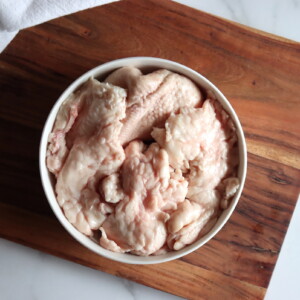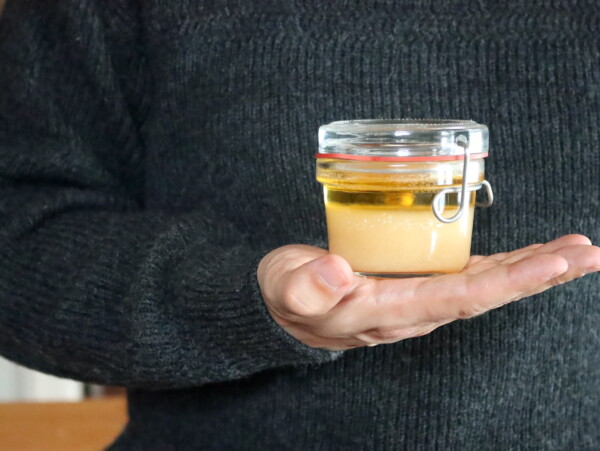This post may contain affiliate links. Please see our disclosure policy.
Rendering goose fat may take some time, but the results are well worth it. Whether you use it for crispy potatoes, sautéing vegetables, or adding depth to stocks, goose fat is a valuable addition to your kitchen repertoire.
Not only do you end up with a rich, versatile fat for cooking, but you also get delicious goose cracklings, which are a tasty kitchen snack!

Rendering goose fat is a kitchen skill that elevates your cooking game, turning a humble byproduct of roasting into a luxurious ingredient. Rich and flavorful, goose fat is prized for its ability to add depth to savory dishes, and it’s particularly revered for roasting potatoes to golden, crispy perfection.
Whether you’re roasting a whole goose for a holiday feast or simply making stock from the bones, knowing how to render and use goose fat opens up a world of delicious possibilities.
How Much Goose Fat Will You Get?
After removing the giblets, most store-bought birds typically weigh about 12 lbs or slightly less. But when you trim away the internal fat and skin, you’re left with about 2 1/2 lbs of fat and excess skin that can be rendered into golden, flavorful goose fat.
After trimming, your bird will weigh around 9 1/2 lbs. The visceral fat (fat surrounding the organs), neck fat, and tail fat are all ideal for rendering, so don’t discard them—these bits will yield some of the richest, most delicious fat for cooking.
That 2 to 3 pounds of fatty trimmings will yield about 1 ½ to 2 quarts of pure white goose fat.
This liquid gold is perfect for crisping goose breasts for your table, and we love goose fat crisped brussel sprouts, too. (And goose fat roasted potatoes are to die for.)

Trimming Goose Fat for Rendering
Before you can render the fat, you’ll need to trim the bird and collect the fat. Here’s how to do it:
Remove the Giblets
Start by taking out the giblets from the cavity of the goose. These include the neck, heart, and liver, and they can be saved for stock or other recipes.
Trim the Fat
Next, trim away the visceral fat (the fat around the internal organs), neck fat, and the tail fat. Also trim away extra skin around the neck and abdominal cavity.
The skin itself is full of fat, and while you want most of it on the bird for roasting, the extra hanging bits won’t get crispy in the oven. It’s much better to trim them and use them for rendering instead.
You’ll want to be as thorough as possible to ensure you’re collecting all the usable fat. It’s helpful to use a sharp paring knife to cut away the fat from the meat, as it can be a little tough to remove.

Cut Fat and Skin into Small Pieces
Once you have the fat and skin separated, chop it into small pieces. The smaller you can chop the fat, the faster and more evenly it will render.
You want to expose as much surface area as possible to the heat to get the maximum amount of fat out.

Rendering Goose Fat
Now that you’ve trimmed and chopped the fat, it’s time to render it into liquid form. The process is simple but requires patience, as rendering goose fat is all about low and slow cooking.
Place your chopped goose fat into a heavy-bottomed pan or Dutch oven. Add about 1 cup of water to the pan. This will help prevent the fat from burning and allow the fat to render slowly as the water evaporates.

Be sure to start slow!
Set your burner to a very low heat. The key to rendering fat properly is low heat, so that the fat melts without frying. If the fat pieces “fry” too quickly, they will crisp on the outside before releasing the fat inside.
Allow the fat to simmer gently. You’ll start to see bubbles appear as the water evaporates. Keep the heat low and let it simmer for at least an hour, stirring occasionally to make sure the fat doesn’t burn or stick to the bottom of the pan.

As the water evaporates, the fat will start to release and the bubbles will change. Once all the water has cooked off, you’ll notice the fat cracklings will begin to brown. These are the crispy bits of skin and fat that you can remove for snacking.
Once the fat is fully rendered, strain it through a fine-mesh sieve into a clean container. This will separate the beautiful golden fat from the cracklings.
The crispy bits left behind are called cracklings and are delicious! You can snack on them as a crunchy treat, or use them as a topping for soups, salads, or even mashed potatoes.
Ways to Use Goose Fat
Now that you have beautiful, rendered goose fat, it’s time to put it to good use. Here are a few delicious ways to incorporate it into your cooking:
Roast Potatoes
Goose fat is legendary for making the crispiest, most flavorful roasted potatoes. Simply toss peeled, chopped potatoes in melted goose fat, season with salt, and roast at a high temperature until golden brown and crispy on the outside while tender inside.
Crisp Leftover Goose
If you’ve roasted a whole goose, there’s a good chance you’ll have plenty of leftover goose in your fridge after the main meal. You can use the rendered fat to reheat and crisp up leftover meat. Gently fry slices of leftover goose in its own fat for a delicious, crispy result.

Sautéing and Frying
Use goose fat in place of butter or oil for sautéing vegetables or frying eggs. Its rich flavor adds a subtle depth to the dishes, especially when used in savory recipes like fried eggs, sauteed greens, or even fried chicken.
Goose Confit
Traditional Duck Confit gets all the attention, but you can make a similar dish with goose meat slow-cooked in its own rendered fat, and it’s just as traditional. Both ducks and geese have enough body fat to confit themselves, provided you trim and render all the bits you can find. The process is the same, and the results are spectacular.
Baking and Pastry
Goose fat is perfect in savory pastries, such as empanadas or pâté brisée (shortcrust pastry), for a rich, flaky texture. It works wonderfully as a substitute for butter in certain recipes, giving your baked goods a more savory, indulgent flavor. We also use it in sweet pastries, in place of shortening. It works wonderfully in pie dough!

How to Render Goose Fat
Ingredients
- 2 1/2 lbs fat and skin from a 12 lb goose, including visceral, neck, and tail fat
- 1 cup water
Instructions
- Separate the fat from the goose, removing any skin and connective tissue. Chop the fat into small pieces to help it render more efficiently.
- Place the chopped fat in a heavy-bottomed pan or Dutch oven. Add 1 cup of water and set the pan over low heat.
- Allow the fat to simmer, stirring occasionally. The water will slowly evaporate, and the fat will begin to render out.
- Once the water has evaporated and the fat has fully melted, the cracklings will start to brown. Remove these crispy bits for snacking or use in other dishes.
- Strain the rendered fat through a fine-mesh sieve into a clean jar or container. Allow the fat to cool and solidify before storing in the refrigerator. The fat will keep for up to 3 months.
Notes
Nutrition
Nutrition information is automatically calculated, so should only be used as an approximation.
Goose Recipes
Looking for more goose recipes?
